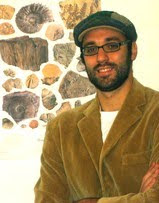 Towards a map of Geologic Art: the tag cloud of my book 'Geology in Art' (built with http://www.wordle.net/).
Towards a map of Geologic Art: the tag cloud of my book 'Geology in Art' (built with http://www.wordle.net/).
When I wrote ‘Geology in Art’, I was astounded by the variety and complexity of the interrelationships between Geology and Art. Music, literature, painting, sculpture… The world of Geologic Art (GeoArt) is vast and underexplored.
At present day, my research aims to trace a map of the GeoArt phenomenon, but many areas are still unexplored. "Hic sunt leones!" I have to thank Anette Petersen for drawing my attention on Per Kirkeby, one of the most internationally acclaimed Danish artists.

Per Kirkeby, Weltuntergang.
I must be sincere now. When I initially approached Kirkeby’s artwork I asked myself: “where’s the geology there?”. Then I started to look better. Those abstract patterns had something familar, although I was not able to discern clear visual references to the geological world. Nevertheless, I knew that those color splashes had ‘something’ geologic. As a geologist, I saw those pattern in the field, so I thought:
It isn’t rock but it is rock.
It isn’t a mudcrack but it is a mudcrack.
They aren’t layers but they are layers.
This is Kirkeby’s Geology.
The structural organization of Kirkeby's Brett Felsen recalls layering. The work was displayed at the Tate Modern Gallery, which hosted a monographic exhibition of the artist in 2009.
Cross-bedding in Middle Old Red Sandstone on the Isle of Bressay, Shetland Islands. Compare it with Kirkeby's Brett Felsen. Photo by Anne Burgess
Now I feel Kirkeby’s artworks as patterns of visual geology. My idea is supported by the artist’s biography. He is a geologist and earned his master's degree in arctic geology, participating to expeditions to the Arctic and Greenland. With the words of artfacts.net: “Vertical structures predominate in these paintings, forming new associations with the landscape motif which has long fascinated the artist. Indeed, ideas about landscape, sedimentation, and layers are key elements in Per Kirkeby's art rooted in the artist's early geological studies at university.” In my opinion, the structure of Kirkeby’s works seems to follow the same constructional ‘rules’ of many geologic elements. This is a very personal (and biased) idea, but these rules could be the self-similarity of fractals. Fractal organization is very common, either in geological structures or in art (you find here a paper about geology and fractals).

Per Kirkeby, Flight to Egypt.

When I saw Kirkeby's 'Flight to Egypt' I thought to through-bedding, then my mind went to thin sections (illustrated). Thin sections are thin slivers of rock, usually examined by geologist under the light of a polarizing microscope.
It appears that Kirkeby’s visions originated by the observation of geology in the field and geology is the ‘magic fluid’ permeating Kirkeby’s aesthetic universe. If somebody would ask me to frame Kirkeby’s role in Earth Sciences, I would answer:
“Kirkeby is Geology’s abstract landscape painter”.
 Towards a map of Geologic Art: the tag cloud of my book 'Geology in Art' (built with http://www.wordle.net/).
Towards a map of Geologic Art: the tag cloud of my book 'Geology in Art' (built with http://www.wordle.net/).









